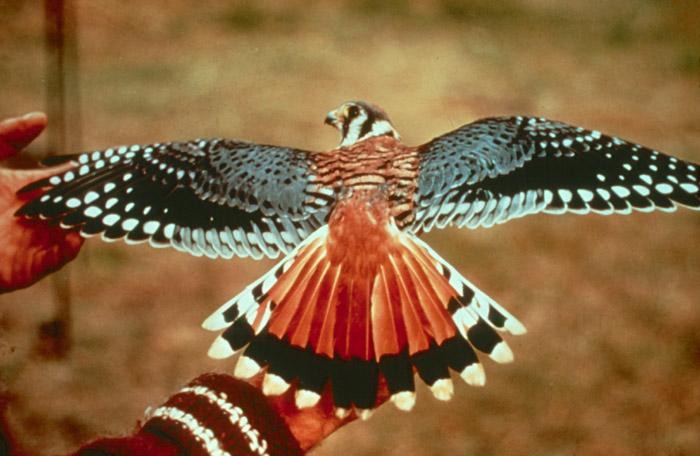American Kestrel (Falco sparverius) - Wiki American Kestrel
From Wikipedia, the free encyclopedia
[Photo] Photo of Male American Kestrel by BLM Birds of Prey Research staff. Photo taken from BLM website.
The American Kestrel (Falco sparverius) is a small falcon. This bird was formerly known in North America as the Sparrow Hawk. This name was misleading because it implied a connection with the Eurasian Sparrowhawk Accipiter nisus, which is unrelated - the latter is a hawk rather than a falcon.
American Kestrels are widely distributed across the Americas. Their breeding range extends from central and western Alaska across northern Canada to Nova Scotia, and south throughout North America, into central Mexico, the Baja, and the Caribbean. They are local breeders in Central America and are widely distributed throughout South America.
Most of the birds breeding in Canada and the northern United States migrate south in the winter, although some males stay as year-round residents.
This small falcon species is a very rare vagrant to western Europe.
Description
The American Kestrel is the smallest falcon in North America - about the size of an American Robin. Like all raptors, the American Kestrel is sexually dimorphic, although there is some overlap within the species. The female ranges in length from 23 to 28 centimeters (9-11 inches) with a wingspan of 53-61 centimeters (21-24 inches) and weighs an average of 120 grams (4.2 ounces). The length of the male varies between 20-25 centimeters (8-10 inches) with a wingspan ranging from 51-56 centimeters (20-22 inches) and weighing an average of 111 grams (3.9 ounces). These subtle differences are often difficult to discern in the field.
The coloration of the feathers, however, greatly varies between the sexes. Males have blue-grey secondary feathers on their wings, while the undersides are white with black barring. The back is rufous in coloration, with barring on the lower half. The belly and flanks are white with black spotting. The tail is also rufous, except for the outer rectrix set, which is white with a black subterminal band.
The back of the female American Kestrel is rufous with dark brown barring. The wings exhibit similar coloration and patterning to the back. The undersides of the females are white with rufous streaking. The tail of the female is noticeably different from the male, being rufous in color with numerous narrow dark brown or black bars. Juveniles exhibit coloration patterns similar to the adults.
In both sexes, the head is white with a bluish-grey top. There are also two narrow, vertical black facial markings on each side of the head; one below the eyes and one on the rear portion of the auriculars. Two black spots (ocelli) can be found on each side of the white or orangish nape. The wings are moderately long, fairly narrow, and taper to a point. While perched, the wingtips are noticeably shorter than the tail tip.
Habitat
American Kestrels are found in a variety of habitats including parks, suburbs, open fields, forest edges and openings, alpine zones, grasslands, marshes, open areas on mountainsides, prairies, plains, deserts with giant cacti, and freeway and highway corridors.
In addition to requiring open space for hunting, American Kestrels seem to need perches for hunting from, cavities for nesting (either natural or man-made), and a sufficient food supply.
Behavior
The American Kestrel is the only North American falcon to habitually hover with rapid wing beats, keeping its head motionless while scanning the ground for prey. The kestrel commonly perches along fences and powerlines. It glides with flat wings and wingtips curved upward. It occasionally soars in circles with its tail spread and its wings flat.
Several hunting techniques are used by the American Kestrel. It will hover over one spot???when prey is sighted the kestrel will partly fold its wings and drop lower once or several times before striking. When the prey disappears the falcon will glide in a semicircle before turning back into the wind to hover again. It will also soar in circles, or figure eights, using the same stooping tactics as when hovering.
The kestrel commonly hunts from elevated perch sites, waiting for prey to move on the ground. The kestrel bobs its head and pumps its tail just before attacking.
Other prey capture techniques include direct pursuit, landing and flushing prey from the ground (especially for grasshoppers)and then taking them in flight, capturing flying insects from an elevated perch, and nest robbing including the burrows of Bank Swallows and the nests of Cliff Swallows. It is also an occasional bat catcher, taking bats from their tree roosts, or striking bats in flight from above or as the bats leave or enter caves. The kestrel will kill and cache food items.
The American Kestrel occasionally robs others of the same species. It has also been known to rob a shrike of its prey. Kestrels sometimes harass other hawks, and even Golden Eagles, in flight.
...
http://en.wikipedia.org/wiki/American_Kestrel
| The text in this page is based on the copyrighted Wikipedia article shown in above URL. It is used under the GNU Free Documentation License. You may redistribute it, verbatim or modified, providing that you comply with the terms of the GFDL. |
